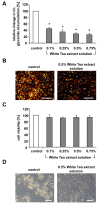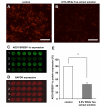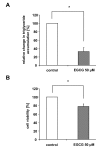White Tea extract induces lipolytic activity and inhibits adipogenesis in human subcutaneous (pre)-adipocytes
- PMID: 19409077
- PMCID: PMC2685800
- DOI: 10.1186/1743-7075-6-20
White Tea extract induces lipolytic activity and inhibits adipogenesis in human subcutaneous (pre)-adipocytes
Abstract
Background: The dramatic increase in obesity-related diseases emphasizes the need to elucidate the cellular and molecular mechanisms underlying fat metabolism. To investigate how natural substances influence lipolysis and adipogenesis, we determined the effects of White Tea extract on cultured human subcutaneous preadipocytes and adipocytes.
Methods: For our in vitro studies we used a White Tea extract solution that contained polyphenols and methylxanthines. Utilizing cultured human preadipocytes we investigated White Tea extract solution-induced inhibition of triglyceride incorporation during adipogenesis and possible effects on cell viability. In vitro studies on human adipocytes were performed aiming to elucidate the efficacy of White Tea extract solution to stimulate lipolytic activity. To characterize White Tea extract solution-mediated effects on a molecular level, we analyzed gene expression of essential adipogenesis-related transcription factors by qRT-PCR and determined the expression of the transcription factor ADD1/SREBP-1c on the protein level utilizing immunofluorescence analysis.
Results: Our data show that incubation of preadipocytes with White Tea extract solution significantly decreased triglyceride incorporation during adipogenesis in a dose-dependent manner (n = 10) without affecting cell viability (n = 10). These effects were, at least in part, mediated by EGCG (n = 10, 50 μM). In addition, White Tea extract solution also stimulated lipolytic activity in adipocytes (n = 7). Differentiating preadipocytes cultivated in the presence of 0.5% White Tea extract solution showed a decrease in PPARγ, ADD1/SREBP-1c, C/EBPα and C/EBPδ mRNA levels. Moreover, the expression of the transcription factor ADD1/SREBP-1c was not only decreased on the mRNA but also on the protein level.
Conclusion: White Tea extract is a natural source that effectively inhibits adipogenesis and stimulates lipolysis-activity. Therefore, it can be utilized to modulate different levels of the adipocyte life cycle.
Figures






Similar articles
-
Lotus leaf extract and L-carnitine influence different processes during the adipocyte life cycle.Nutr Metab (Lond). 2010 Aug 5;7:66. doi: 10.1186/1743-7075-7-66. Nutr Metab (Lond). 2010. PMID: 20687953 Free PMC article.
-
Comparison of Cytotoxicity and the Anti-Adipogenic Effect of Green Tea Polyphenols with Epigallocatechin-3-Gallate in 3T3-L1 Preadipocytes.Am J Chin Med. 2015;43(6):1177-90. doi: 10.1142/S0192415X15500676. Am J Chin Med. 2015. PMID: 26446202
-
Effects of Rosmarinus officinalis extract on human primary omental preadipocytes and adipocytes.Exp Biol Med (Maywood). 2015 Jul;240(7):884-95. doi: 10.1177/1535370214562341. Epub 2015 Feb 20. Exp Biol Med (Maywood). 2015. PMID: 25710930 Free PMC article.
-
Korean Chungtaejeon tea extract attenuates body weight gain in C57BL/6J-Lep ob/ob mice and regulates adipogenesis and lipolysis in 3T3-L1 adipocytes.J Integr Med. 2017 Jan;15(1):56-63. doi: 10.1016/S2095-4964(17)60321-2. J Integr Med. 2017. PMID: 28088260
-
Functional antagonism between inhibitor of DNA binding (Id) and adipocyte determination and differentiation factor 1/sterol regulatory element-binding protein-1c (ADD1/SREBP-1c) trans-factors for the regulation of fatty acid synthase promoter in adipocytes.Biochem J. 1999 Dec 15;344 Pt 3(Pt 3):873-80. Biochem J. 1999. PMID: 10585876 Free PMC article.
Cited by
-
Effect of Abutilon indicum (L) Extract on Adipogenesis, Lipolysis and Cholesterol Esterase in 3T3-L1 Adipocyte Cell Lines.Indian J Clin Biochem. 2023 Jan;38(1):22-32. doi: 10.1007/s12291-022-01022-2. Epub 2022 Apr 6. Indian J Clin Biochem. 2023. PMID: 36684487 Free PMC article.
-
Tea's anti-obesity properties, cardiometabolic health-promoting potentials, bioactive compounds, and adverse effects: A review focusing on white and green teas.Food Sci Nutr. 2023 Aug 15;11(10):5818-5836. doi: 10.1002/fsn3.3595. eCollection 2023 Oct. Food Sci Nutr. 2023. PMID: 37823174 Free PMC article. Review.
-
White tea (Camellia sinensis Kuntze) exerts neuroprotection against hydrogen peroxide-induced toxicity in PC12 cells.Plant Foods Hum Nutr. 2011 Mar;66(1):22-6. doi: 10.1007/s11130-010-0203-3. Plant Foods Hum Nutr. 2011. PMID: 21271291
-
White Tea Aqueous Extract: A Potential Anti-Aging Agent Against High-Fat Diet-Induced Senescence in Drosophila melanogaster.Foods. 2024 Dec 13;13(24):4034. doi: 10.3390/foods13244034. Foods. 2024. PMID: 39766976 Free PMC article.
-
Acute change in resting energy expenditure and vital signs in response to white tea consumption in females: a pilot study.Nutr Metab (Lond). 2024 Nov 7;21(1):88. doi: 10.1186/s12986-024-00867-z. Nutr Metab (Lond). 2024. PMID: 39511670 Free PMC article.
References
LinkOut - more resources
Full Text Sources
Other Literature Sources

